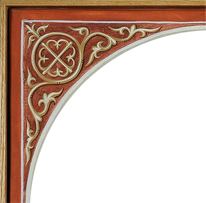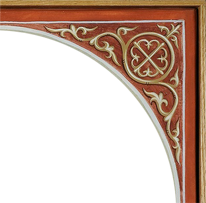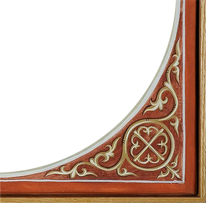The Transfiguration of Lord Jesus Christ on Mount Tabor, where His appearance changed and became light-like, is described by Evangelists Matthew, Mark and Luke. The Transfiguration took place six days after the Saviour had told about His forthcoming Sufferings on the Cross. The Crucifixion followed in about forty days after Transfiguration. The evangelist Matthew described Our Saviour's Transfiguration as follows:
"And after six days Jesus taketh Peter, James, and John his brother, and bringeth them up into an high mountain apart, And was transfigured before them: and his face did shine as the sun, and his raiment was white as the light. And, behold, there appeared unto them Moses and Elias talking with him. Then answered Peter, and said unto Jesus, Lord, it is good for us to be here: if thou wilt, let us make here three tabernacles; one for thee, and one for Moses, and one for Elias. While he yet spake, behold, a bright cloud overshadowed them: and behold a voice out of the cloud, which said, This is my beloved Son, in whom I am well pleased; hear ye him. And when the disciples heard it, they fell on their face, and were sore afraid. And Jesus came and touched them, and said, Arise, and be not afraid. And when they had lifted up their eyes, they saw no man, save Jesus only. And as they came down from the mountain, Jesus charged them, saying, Tell the vision to no man, until the Son of man be risen again from the dead. And his disciples asked him, saying, Why then say the scribes that Elias must first come? And Jesus answered and said unto them, Elias truly shall first come, and restore all things. But I say unto you, That Elias is come already, and they knew him not, but have done unto him whatsoever they listed. Likewise shall also the Son of man suffer of them" (Matt 17:1-12).
The place of Transfiguration is not named by any of the Evangelists, but the ancient tradition unanimously points at Tabor, a mountain in Galilee, six kilometers south-east of Nazareth. Jesus Christ spent His youth not far from this mountain and probably many times climbed it and prayed on its top. About one kilometer high, Mount Tabor stately rises above surrounding plains and attracts looks of wayfarers in every direction. From its top a view opens to the Sea of Galilee and the River Jordan lying in the east of it. The mountain is covered with magnificent oaks and pistachio trees from foot to middle.
The Saviour did not bring all His disciples up to the mountain, but only three of them (Peter, James and his brother John the Theologian), while the others stayed at the foot of the mountain. Going uphill was tiring, and the Apostles accompanying Christ laid down for rest and dozed off; the Saviour started praying. During the prayer, the looks of Our Saviour changed: His face shone as the sun, and His clothes became white as the light. The bright light woke up the Apostles and they saw their Teacher in His heavenly glory of the Son of God. His Divinity shone through His flesh and clothing.
Looking at the Saviour in astonishment, the Apostles saw two unfamiliar figures who, as it turned up later, were ancient prophets Moses and Elias coming to Christ from the world invisible. The Evangelists do not explain why these two prophets came. Supposedly, the coming of the two most authoritative Old Testament righteous people was the evidence of Christ's Divinity for the Apostles and for all Jews. The appearance of the ancient prophets who had gone to the better world must convince us the Christians that the life of a human does not end with the death, and that the souls of those who died are not sleeping, as some sectarians erroneously teach, but are awake, living a full-scale spiritual life. Jesus Christ has power over life and death, as He says, "I have the keys of hell and of death" (Rev. 1:18).
The conversation of Moses and Elias with Christ was to encourage the Apostles and strengthen their faith in Christ when the Suffering on the Cross was close ahead. The Apostles indeed thought about their Teacher's suffering as humiliation and dishonor, but the prophets called it "glory" that He intended to manifest in Jerusalem. And right before the Crucifixion the Saviour viewed the impending suffering and dishonorable death as the beginning of glorification of His Father and Himself as the Saviour of the mankind; He said, "Father, the hour is come; glorify thy Son, that thy Son also may glorify Thee" (John 17:1).
The special graceful state of the Apostles during the Saviour's Transfiguration was expressed by Saint Peter who said, "Lord, it is good for us to be here!" Delighted by the glorious vision, Peter wished that it would last, and last forever, if possible. So Peter suggested to the Saviour to make three tabernacles, or pavilions, on the top of the mountain (Jews and other oriental people made 'tabernacles' by digging a pole in the ground, stretching ropes from its top to pegs driven at a certain distance around it, and covering up with fabric; sometimes skins or leaves and bark were used instead). The Apostle Peter did not want to come back to the insidious and malicious world where his Teacher was threatened by suffering and death.
As the Evangelists say, at that moment everyone on the mountain was overshadowed by a bright cloud, which indicated the presence of God the Father (a dark cloud is symbol and sign of God the Just Judge (Ex. 24:18; 19:18), while a bright cloud is the symbol and sign of the presence of God Merciful. A similar bright cloud, called shekina in the Bible, was at times seen above the Sanctuary, the main part of the Judean temple (1 Kings 8:10-11; Ezek 1:4; 10:4), and a mysterious voice was heard from the cloud like it was during Theophany, "This is my beloved Son, in whom I am well pleased," and also, "Hear Him." These last words were to remind the Apostles of Moses' ancient prophesy of the Forthcoming Great Prophet Who would herald God's will to the Jews. "Whosoever will not hearken unto my words which he shall speak in my name, I will require it of him," says God in Deuteronomy 18:19. So here on Tabor fifteen hundred years later God the Father gave the evidence of Moses' prophesy about the Messiah as the Greatest of prophets.
Hearing the voice from the cloud, the disciples fell on the ground in fear. Everything was unusual for them here on the mountain: the seclusion and height of the place, the deep silence of nature, the appearance of the prophets of the past, the light of extreme brightness and finally the voice of God the Father Himself.
When they were coming down, Jesus forbade the Apostles to tell anyone what had happened on the mountain until His rising from the dead. The Lord transfigured in order to affirm to His trusted disciples that He indeed was the Messiah. Still it was too early to tell about the Transfiguration to the Jewish public at large whose senses would anticipate the Messiah as a powerful king and conqueror. One of the eye witnesses of this event, Apostle Peter, later recalled it as unquestionably trustworthy and brought it forth as proof of Christ's divine nature (2 Peter 1:16-18).



